
A dinghy is a type of small boat, often carried or towed by a larger vessel for use as a tender. Utility dinghies are usually rowboats or have an outboard motor. Some are rigged for sailing but they differ from sailing dinghies, which are designed first and foremost for sailing. A dinghy's main use is for transfers from larger boats, especially when the larger boat cannot dock at a suitably-sized port or marina.
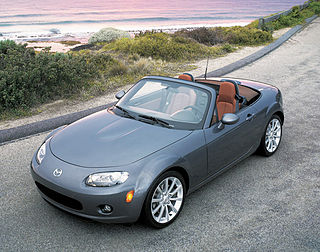
A convertible or cabriolet is a passenger car that can be driven with or without a roof in place. The methods of retracting and storing the roof vary among eras and manufacturers.
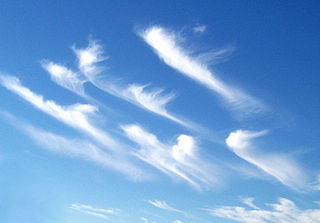
Wind shear, sometimes referred to as wind gradient, is a difference in wind speed and/or direction over a relatively short distance in the atmosphere. Atmospheric wind shear is normally described as either vertical or horizontal wind shear. Vertical wind shear is a change in wind speed or direction with a change in altitude. Horizontal wind shear is a change in wind speed with a change in lateral position for a given altitude.
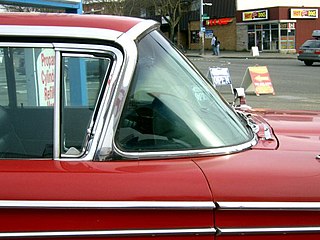
The windshield or windscreen of an aircraft, car, bus, motorbike, truck, train, boat or streetcar is the front window, which provides visibility while protecting occupants from the elements. Modern windshields are generally made of laminated safety glass, a type of treated glass, which consists of, typically, two curved sheets of glass with a plastic layer laminated between them for safety, and bonded into the window frame.

In meteorology, precipitation is any product of the condensation of atmospheric water vapor that falls from clouds due to gravitational pull. The main forms of precipitation include drizzle, rain, sleet, snow, ice pellets, graupel and hail. Precipitation occurs when a portion of the atmosphere becomes saturated with water vapor, so that the water condenses and "precipitates" or falls. Thus, fog and mist are not precipitation but colloids, because the water vapor does not condense sufficiently to precipitate. Two processes, possibly acting together, can lead to air becoming saturated: cooling the air or adding water vapor to the air. Precipitation forms as smaller droplets coalesce via collision with other rain drops or ice crystals within a cloud. Short, intense periods of rain in scattered locations are called showers.

A spinnaker is a sail designed specifically for sailing off the wind on courses between a reach to downwind. Spinnakers are constructed of lightweight fabric, usually nylon, and are often brightly colored. They may be designed to perform best as either a reaching or a running spinnaker, by the shaping of the panels and seams. They are attached at only three points and said to be flown.

Bimini is the westernmost district of the Bahamas and comprises a chain of islands located about 80 kilometres (50 mi) due east of Miami. Bimini is the closest point in the Bahamas to the mainland United States and approximately 210 km (130 mi) west-northwest of Nassau. The population is 2,417 as of the 2022 census.
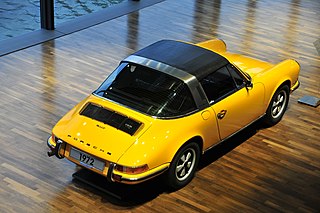
Targa top, or targa for short, is a semi-convertible car body style with a removable roof section and a full-width roll bar behind the seats. The term was first used on the 1966 Porsche 911 Targa, and it remains a registered trademark of Porsche AG.

A windbreaker, or a windcheater, is a thin fabric jacket designed to resist wind chill and light rain, making it a lighter version of the jacket. It is usually of lightweight construction and characteristically made of a synthetic material. A windbreaker often uses elastic waistbands, and/or armbands, and a zipper to allow adjustments for the current weather conditions.

A tonneau is an area of a car, truck, or boat open at the top. It can be for passengers or cargo. When applied to trucks it refers to their bed or tray.

An awning or overhang is a secondary covering attached to the exterior wall of a building. It is typically composed of canvas woven of acrylic, cotton or polyester yarn, or vinyl laminated to polyester fabric that is stretched tightly over a light structure of aluminium, iron or steel, possibly wood or transparent material. The configuration of this structure is something of a truss, space frame or planar frame. Awnings are also often constructed of aluminium understructure with aluminium sheeting. These aluminium awnings are often used when a fabric awning is not a practical application where snow load as well as wind loads may be a factor.

An aircraft canopy is the transparent enclosure over the cockpit of some types of aircraft. An aircraft canopy provides a controlled and sometimes pressurized environment for the aircraft's occupants, and allows for a greater field of view over a traditional flight deck. A canopy's shape is a compromise designed to minimize aerodynamic drag, while maximizing visibility for pilots and other crewmembers.
Marine canvas refers to a varied array of fabrics used in the fabrication and production of awnings, covers, tarps, sunshades, signs and banners for the advertising, boating, trucking, tenting, structural and medical industries. The term "marine canvas" is also used more narrowly to refer specially to boat cover products.
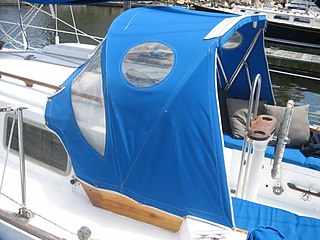
A dodger is a frame-supported canvas structure partially protecting a helmsman and other occupants of a sailboat from harsh weather and seas. It covers part of the cockpit and the entrance into the interior of the sailboat. One can usually stand under a dodger and be protected from rain, spray and snow travelling straight down or from the front/fore of the craft. There is little protection afforded from elements moving from aft to fore, but since the boat is usually moving forward or anchored by the bow and therefore facing into the wind this is seldom a problem. A similar type of shelter on a boat, without the forward and side protection, is called a Bimini top. Increased protection for the occupants of the cockpit is possible using a combination of dodgers/bimini tops and dodger extension.

Islands in the Stream (1970) is the first of the posthumously published novels of Ernest Hemingway. The book was originally intended to revive Hemingway's reputation after the negative reviews of Across the River and Into the Trees. He began writing it in 1950 and advanced greatly through 1951. The work, rough but seemingly finished, was found by Mary Hemingway among 332 works Hemingway left behind at his death. Islands in the Stream was meant to encompass three stories to illustrate different stages in the life of its main character, Thomas Hudson. The three different parts of the novel were originally to be titled "The Sea When Young", "The Sea When Absent" and "The Sea in Being". These titles were changed, however, into what are now its three acts: "Bimini", "Cuba", and "At Sea".
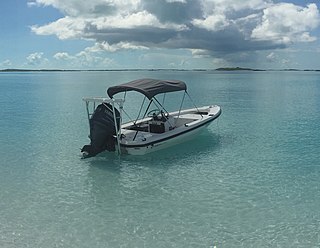
A center console sometimes abbreviated as CC, is a type of single-decked open hull boat where the helm is in the center. There is a cabin on some models; these are usually located in the bow and hold small berths for sleeping. Small berths may also be located inside the console and under the deck of larger center console boats. An advantage of this type of boat, especially in fishing, underway, and at rest, is that person can walk all around the boat from stern to bow with ease which aids in various activities by removing obstacles which may be encountered with other boat designs.

An overshooting top is a dome-like protrusion shooting out of the top of the anvil of a thunderstorm and into the lower stratosphere. When an overshooting top is present for 10 minutes or longer, it is a strong indication that the storm is severe.

A cowl is a usually hood-shaped covering used to increase the draft of a chimney and prevent backflow. The cowl, usually made of galvanized iron, is fitted to the chimney pot to prevent wind blowing the smoke back down into the room below. Undoubtedly named after the resemblance of many designs to the cowl garment worn by monks, they have been in use for centuries.
The Hunter 212 is an American trailerable sailboat that was designed by Chuck Burns as a day sailer and cruiser and first built in 1996.
The Hunter 49 is an American sailboat that was designed by Glenn Henderson and the Hunter Design Team as a cruiser and first built in 2007.

















